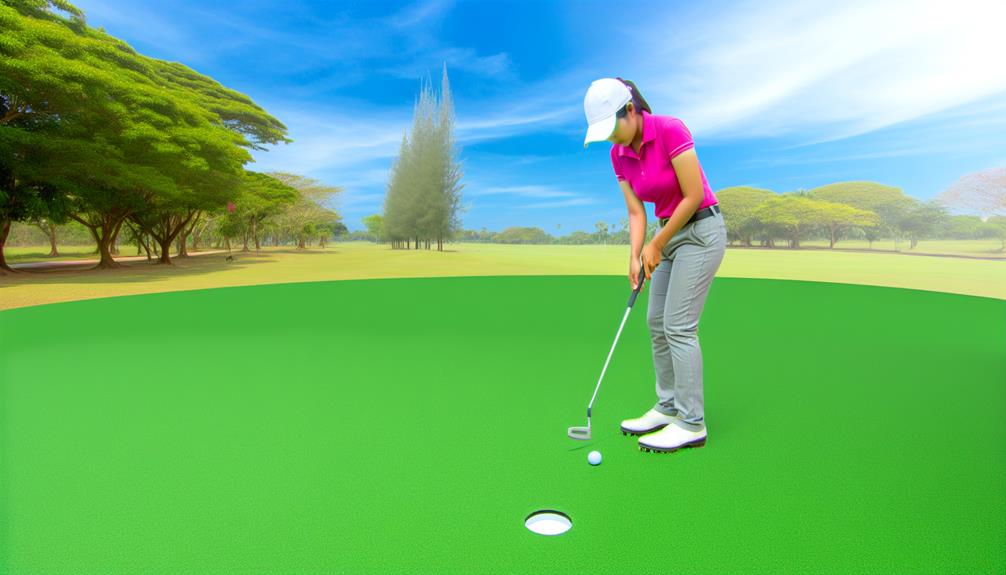As Sun Tzu once alluded, every battle is won before it's ever fought, and so it is with golf. You're on the green, your opponent's ball is inches from the hole, and it's your turn to putt.
You feel the weight of the club in your hands, the hush of the crowd, and the scrutiny of the rules committee. It's a situation that demands not just skill, but also a comprehensive understanding of the intricate rules and regulations that govern golf putting strokes.
Are you sure you're up to date with the latest guidelines? Do you know how to avoid penalties and leverage special cases? Let's find out, shall we?
Understanding the Putting Green
Grasping the intricacies of the putting green is crucial to mastering your golf putting stroke. This means understanding not only putting techniques but also the significance of green maintenance.
Firstly, you should know that the condition of the green greatly influences your stroke. The green's maintenance affects its speed and smoothness. A well-maintained green, free of divots and debris, allows a more predictable ball path. So before you line up your putt, assess the green. Look for any signs of damage or inconsistency that could affect your putt.
When it comes to putting techniques, consistency is key. Your grip, alignment, and stroke should be reliably identical each time. This consistency allows you to better control your ball's speed and direction. It's not just about strength, it's about precision and control.
Lastly, remember to practice reading the green. This involves understanding the slope, grain, and moisture levels, all of which affect how your ball moves. The more you practice, the better you'll get at predicting how these factors influence your putt.
Basic Rules of Golf Putting
Delving into the basic rules of golf putting, you'll find that precision, control, and adherence to certain regulations are essential for a successful putt. It's important to understand the role of your club, the ball, and the green in making a perfect putt.
Firstly, let's talk about Putt Alignment Techniques. Your ball should be positioned in the center of your stance, and your eyes should be directly over the ball. This ensures that you're lined up correctly with the hole. Remember, you can't touch the line of putt once you've addressed the ball.
Next, Club Selection Advice comes into play. The putter is the optimal choice for putting, offering the most control and precision. It's the shortest club in your bag, making it easier to manage. Its flat face helps you direct the ball accurately. However, if you're on the fringe of the green, a chipper or an iron might be a better choice.
Stroke Penalties in Putting
While mastering the techniques of putting and club selection is crucial, it's equally important to be aware of potential stroke penalties that can occur during putting. These can significantly impact your score, leading to a disappointing finish. Stroke penalties often result from stroke calculation errors, so it's vital to keep an accurate count of your strokes.
One common penalty arises from hitting the ball more than once during a single stroke. Another occurs if you strike the ball while it's still in motion. Also, should you touch the ball or cause it to move, you'll get a one-stroke penalty.
Now, let's talk about penalty avoidance strategies. Firstly, always wait for the ball to completely stop moving before making your next stroke. Secondly, take care not to touch the ball or the hole with your putter before making a stroke. Lastly, maintain a careful count of your strokes to avoid calculation errors.
Special Cases in Golf Putting
In the realm of golf putting, there are several special cases that warrant your attention and understanding to avoid penalties and perfect your putting stroke. Unorthodox techniques and equipment variations can sometimes lead to confusion, but don't worry, we've got you covered.
Let's start with unorthodox techniques. You might see some players using sidesaddle putting, where they face the hole directly rather than standing parallel to the putting line. This isn't illegal, but remember, the clubhead must strike the ball, not push it.
Now, onto equipment variations. The long putter is a popular variant, especially among players with back issues. However, you can't anchor the top of the putter against your body while making a stroke, a rule enforced to maintain the challenge of controlling the entire club.
Another special case is the double hit. It's rare, but if you hit the ball twice in one stroke, it counts as two strokes and incurs a penalty.
Lastly, if your ball moves after you've addressed it but before you've made your stroke, replace it without penalty, unless you caused the movement. Then, it's a one-stroke penalty.
Understanding these special cases will keep your game fair, and help hone your putting skills.
Deciphering Putting Disputes
Having grasped the nuances of special cases in putting, it's now crucial to explore how to decipher putting disputes, an inevitable part of the game that can greatly affect your score.
When a dispute arises, the primary step is to understand the exact nature of the disagreement. Is it a question of whether a stroke was made, or perhaps a disagreement over the position of the ball? Once you've identified the issue, you're in a better position to find a resolution.
Effective dispute resolution in golf depends heavily on both rules knowledge and sportsmanship ethics. It's essential for all players to have a solid understanding of the game's rules. However, it's equally important to approach disputes with an attitude of fairness and respect for your fellow golfers. Remember, the goal isn't just to win—it's to play the game in a way that upholds its integrity and traditions.
In cases where a dispute can't be resolved on the green, it may be necessary to consult with an official. But in most instances, a combination of solid rules knowledge, good sportsmanship, and respectful communication can help resolve putting disputes quickly and fairly.

